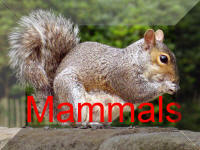Harvest Mouse Micromys minutus Back To

Description:
Blunt nose and small hairy ears in contrast to other British species of mice and also much smaller; prehensile tail the same length as the head and body; russet orange fur with a white underside.
Head/body length: 50-70mm.
Weight: 4-6g.Ecology:
Harvest Mice are mainly found from central Yorkshire southwards with isolated records from Scotland and Wales which probably result from the release of captive animals. Harvest mice are extremely active climbers and feed in the stalk zone of long grasses and reeds particularly around dusk and dawn. Their hearing is acute and they will react sharply and either freeze or dive for cover to rustling sounds up to 7m away. Although their vision is not particularly good they will react to a change in silhouette.Diet
Wild harvest mice have high energy requirements; the cost of being warm blooded and coping with a high surface to volume ratio. They are thought to eat a mixture of seeds, berries and insects although moss, roots and fungi may also be taken. Harvest mice sometimes take grain from cereal heads leaving characteristic sickle-shaped remains. Noticeable damage to cereal crops is extremely rare.
Biology
Breeding nests are the most obvious sign indicating the presence of harvest mice. The harvest mouse is the only British mouse to build nests of woven grass well above ground. They are generally located on the stalk zone of grasses; at least 30cm above ground in short grasses and up to a metre in tall reeds. The nest can vary from 10cm in diameter for breeding nests to only 5cm for non-breeding nests and tend to be found in dense vegetation such as grasses, rushes, cereals grassy hedgerows, ditches and brambles. Nests are built by pregnant females, usually at night. The female shreds lengths of grass, which are still attached to the stalk with her incisors while sitting on another stalk and supported by her hind feet and tail. Having shred a large number of leaves in this way they are woven together to form an outer framework for the nest. The nest is then lined by pulling further grasses through the wall until it is densely woven without leaving an obvious entrance. Nests tend to stand out more in winter when the surrounding vegetation dies back.
Harvest mice usually have two or three litters a year in the wild between late May and October or even December if the weather is mild although most litters are born in August. Cold wet weather is a major cause of mortality. There are usually around six young in a litter which are born in the carefully woven grass nests. The young are born blind and hairless but grow extremely quickly and start to explore outside the nest by the 11th day. The young are abandoned after about 16 days and continue using the nest which may at this stage start to look rather dilapidated. A fresh nest is built for each litter.
Conservation:
Harvest mice are not legally protected in Britain. Changes in habitat management and agricultural methods are thought to have caused a reduction in abundance although there have been no studies to quantify this change.Harvest mice have many predators; weasels, stoats, foxes, cats, owls, hawks, crows even pheasants. They generally form only about 1% of barn owl pellets.
